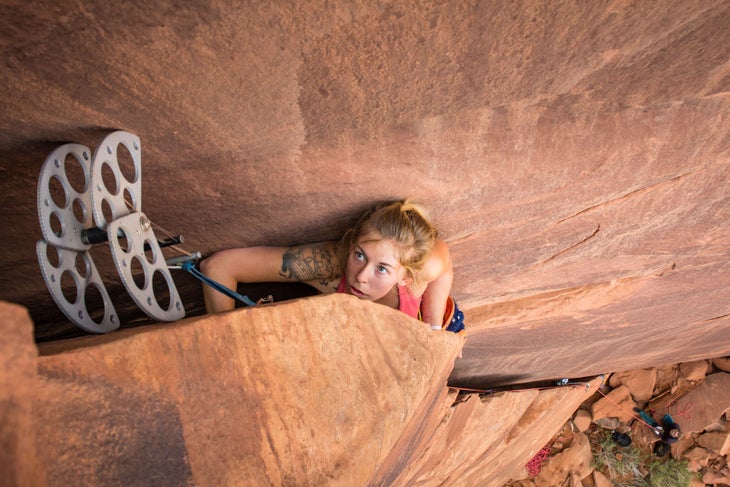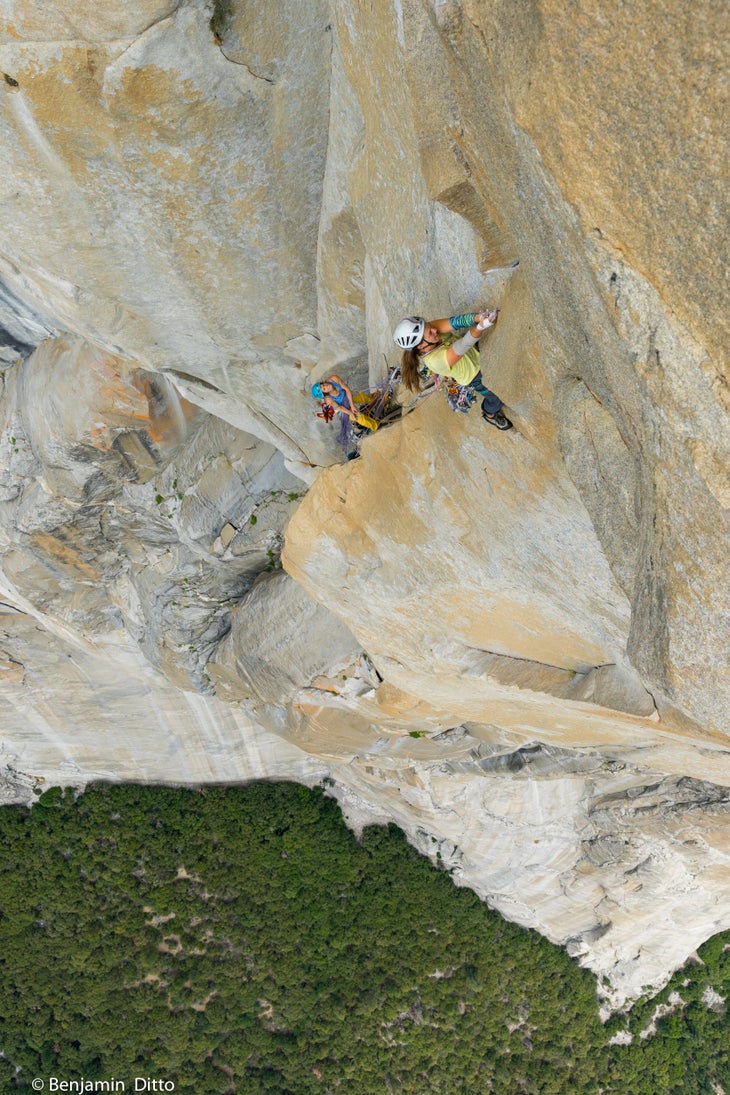Heading out the door? Read this article on the new Outside+ app available now on iOS devices for members! Download the app.

In 1996, when I started climbing, I could count female role models on one hand: Lynn Hill, Steph Davis, Robyn Erbesfield-Raboutou, and Kitty Calhoun. And then Katie Brown and Beth Rodden came on the scene, but they were kids, and while they impressed me, I didn’t feel as if I could “look up” to them. I was a college student focused on graduating—I found it challenging to identify with girls younger than me who were traveling the world competing and climbing, seemingly bereft of “adult” responsibilities.
At the crags, guys abounded, sometimes trailed by the token girlfriend climber, usually relegated to belay slave—the Princess Leias tied to their Jabba the Hutts. Back then, I had better luck finding a step class than a climbing gym. Then, when I did find indoor climbing, I was usually the only woman in the dark, dusty bouldering cave. The guys weren’t unfriendly—they just didn’t know what to do with a woman on her own. Only when I cranked out my 25 pull-ups would any of them talk to me.
But the scene slowly evolved. More climbing gyms opened, helping garner more interest in the sport with youth classes, women’s-specific trainings, and yes, even those ubiquitous birthday parties. In 1999, Rodden became the youngest female to climb To Bolt or Not to Be (5.14a) at Smith Rock. A month later, she joined Hill on a women’s-only big wall expedition to Madagascar. That same year saw Brown’s onsight of Omaha Beach (5.13d) at Kentucky’s Red River Gorge. Suddenly, seeing more than a few women’s names linked with cutting-edge ascents became common.
Women’s-specific events started garnering interest, too. Established in 1999, Chicks with Picks encouraged women to climb ice. Events like the Red Rock Rendezvous added women’s-only clinics. Today, there are events devoted solely to women, like Flash Foxy’s Women’s Climbing Festival in Bishop, California, and weekend women’s-only trips like those hosted by Chicks Climbing & Skiing (formerly Chicks with Picks).
The number of women at the crags increased, too. No longer was I one of the few women climbing at Kootenai Canyon outside Missoula, Montana, or bouldering in Bishop. I started seeing groups of just women—no men. At the American Bouldering Series Open National Championships in 2006, 35 percent of competitors were women; in 2014, it was 43 percent.
Sure, it’s been a slow evolution, but even tiny drops of water can erode granite given enough time. Today, we have women dominating the climbing world. Ashima Shiraishi sent Horizon (V15), and then three months later took down another V15 in Australia, Sleepy Rave. Margo Hayes became the first woman to climb 5.15a with La Rambla. [Ed. Since this story was published in our print edition, Angy Eiter became the first woman to climb 5.15b.] Women are making a name for themselves as not only top female climbers, but as top climbers—of either gender.
But what triggered the change? Climbing is one of the few sports where it’s possible to level the playing field. Women’s superior strength-to-weight ratio helps offset anything we may lack in power or reach, bridging the gap between the sexes. But this has always been true. The tools to climb hard were in us all along. So why the big shift now?
“I think this has developed over the years, and it’s not just a random occurrence,” says Molly Mitchell of the shifts in women’s climbing she’s witnessed during her seven years in the sport. Mitchell, a Las Vegas resident, is known for first ascents of R- and X-rated trad lines—climbs like Element X (5.13a X) in Eldorado Canyon, Colorado, and All Hell Breaks Moose (5.13 R) in Moab, Utah. Mitchell grew up in Atlanta; she recalls a trip with her father when she was 10 to Yosemite, where she first saw people rock climbing and even got to try toproping. At 16, when she got her driver’s license, Mitchell could finally commute the 45 minutes to the nearest climbing gym, and picked up the sport in earnest. She refers to my own heroines, saying, “The women who were pushing the limits years ago are now still role models for the young girls now.” She cites Erbesfield-Raboutou, noting that she’s a four-time World Cup champion and the third woman in the world to climb an 8b+/5.14a with her 1993 ascent of Attention on Vous Regarde in France, and is now coaching the next generation, including Robyn’s own daughter, Brooke Raboutou.
“People like that who are selfless in helping push the sport, who care about supporting and teaching other athletes, have propelled the sport forward, especially for females,” says Mitchell. Other veterans impacting young climbers include Steph Davis, with her crack-climbing clinics, and Hill, through her private coaching.
Angela Van Wiemeersch, a climbing transplant from Detroit’s fringe punk culture, with a multitude of FAs including Last Man Standing (WI6 PDW; 400 feet) in Zion National Park, Utah, and The One Who Knocks (WI6 M5 R/X; 450 feet) in the Uinta Range of Utah, has a different take: “We have more access, more knowledge, and generally more female interest in the sport than ever,” she says. “As a community, we are improving at highlighting women’s achievements as an objective accomplishment as an athlete, not just as a female.” Van Wiemeersch also notes that the media today strives for equal coverage of both male and female climbers—for instance, we’re seeing more pictures of women on the covers of climbing magazines.

Social media is surely one of the great drivers of our new, improved reality. Christina Grunwald Freschl is a small-town girl from Wisconsin who caught the climbing bug on a family trip to Yosemite in 1998. Since her first trip up Swan Slab, she’s built an impressive résumé of Valley offwidths, including Blind Faith (5.11d) on the Rostrum and a rare ascent of Basket Case (5.11b) on Basket Dome. Freschl agrees that, more than anything else, social media has impacted the increase in female climbers. “Women are posting about accomplishments, and this inspires or challenges other women to get out there and do more,” she says. It’s no coincidence that 2012 saw a boom in Instagram’s popularity, and also an increase in female competition climbers. According to the American Bouldering Series, girls have since come to comprise 50 percent of all competitors.
As Salt Lake City native Ashley Cracroft—another offwidth masochist with an FA of Wapiti Crack (5.13a), 110-plus feet of 5–9” crack in Utah’s North Wash—says, “There is just something magical about women empowering other women. When there is a community of women to support each other, boundaries start getting pushed.”
Another trend is that of women climbers moving into “blue-collar” styles that were previously the domain of stubble-jawed bros. Ice climbing, sketchy trad, offwidths—now women’s names dominate these former boys’ clubs. Look at Pamela Pack, hands-down one of the best offwidth climbers, male or female, with more than 50 first female offwidth ascents in the American West. In 2009, she was the recipient of Climbing Magazine’s Golden Piton Award for establishing Gabriel (5.13c), a 65-foot inverted offwidth in Zion National Park. Or Hazel Findlay, pushing the deathfall potential on trad climbs, as with her first female ascent of Once Upon a Time in the Southwest (E9 6c) in Devon, England.
Fading into obscurity are the days where women stuck to styles that were “better for women,” like tips splitters or delicate face climbs. We’ve left our comfort zones, pushed along by social media and encouraged by other climbers—some of them even men.
Take Van Wiemeersch, who recalls herself as “scared of every move” and “highly uncoordinated” on rock but who, once she gravitated toward ice, began to excel in her new métier—one to which she was introduced by a mountain man named Courtney who picked her up as she hitchhiked across the country in fall 2012. He regaled her with tales of the amazing ice climbing in the San Juan Mountains of Colorado. A month later, she moved to Ouray. “[On ice], every climb was the coolest thing I had ever done in my life. I loved the beauty, the chase, and ultimately the movement,” explains Van Wiemeersch.
Mitchell discovered her aptitude for performing well in heady situations when she left the gym world. “I like finding climbs with minimal gear placements and hard movement, especially first ascents,” she says. “It becomes super real in those situations. I focus and perform better when I’m runout on gear or above questionable pieces—when I have no other choice.” Mitchell tried other styles, trying to fit into the “norms” of the climbing world, but realized she wasn’t happy following other people’s paths. “I know I’m a little crazy, but embracing my craziness has always made me feel like I’m living life to the fullest,” she says.
And then there’s the world of offwidths, the onetime stronghold of men like Bob Scarpelli and Craig Luebben, kings reigning over the Vedauwoo scene, or California climbers like John Long, Randy Leavitt, Steve Schneider, and Tony Yaniro. They revolutionized offwidth crack techniques, raising the bar of what was thought possible.
I spoke with several top women offwidth climbers, and one thing stood out among each: She originally came to offwidths to become a better all-around climber.
“All my friends think I’m an idiot for climbing those things,” laughs Christina Natal, who’s fought her way up climbs like Massachusetts’s Bulletproof (5.13) and hopes to bring her wide-crack skills to the alpine world. “That is, until I offer to take all the OW pitches on our next route.” As a climber in the Gunks, her only experience had been with horizontal cracks, until she started seeking out vertical cracks to become a more well-rounded climber. “Most people hate offwidths, but, man, I loved that struggle. It wasn’t pretty or glorious, but it took everything I had and I loved that,” Natal says. “As I climbed more of them and got a little better, I realized how delicate they were. These seemingly brutal battles were actually filled with subtlety and grace.”
Cracroft agrees that there is a lot more grace involved than people think—offwidths are more suited to women’s strengths than it might initially appear. She doesn’t consider herself a masochist. “If anything,” she says, “I would say that I’m determined. This is a full-body style of climbing, and it takes everything I have sometimes just to move an inch. I find it very rewarding to finish a climb where every inch was a battle won.”
And in the end, that’s what climbing is all about: the battle with yourself—fighting for every inch to uncover some deeper layer of meaning within. Maybe that’s why we’re finally seeing women breaking free of the more traditional “female styles”—today we feel more empowered to find our own way, break free of the mold, and climb what we want to climb. Women have decided to follow their hearts.
“The future of women’s climbing is bright,” says Van Wiemeersch. “We’re already kicking so much ass. We’ve got an incredible community, amazing role models, and enough positive attitude to turn Cruella de Vil into a vegan. Can’t wait to see what’s next.”